Published Studies
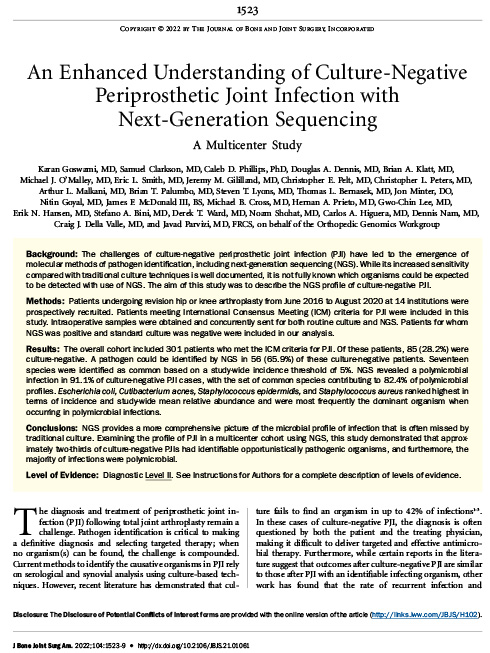
An Enhanced Understanding of Culture-Negative Periprosthetic Joint Infection with Next-Generation Sequencing A Multicenter Study
THE JOURNAL OF BONE AND JOINT SURGERY, INCORPORATED 2022 Sep 7;104(17):1523-1529
Study: NGS provides a more comprehensive picture of the microbial profile of infection that is often missed by traditional culture. Examining the profile of PJI in a multicenter cohort using NGS, this study demonstrated that approximately two-thirds of culture-negative PJIs had identifiable opportunistically pathogenic organisms, and furthermore, the majority of infections were polymicrobial. Read Study
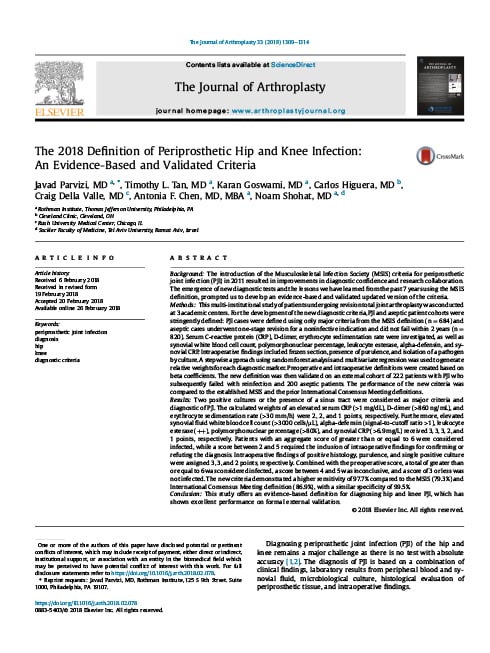
The 2018 Definition of Periprosthetic Hip and Knee Infection: An Evidence-Based and Validated Criteria
The Journal of arthroplasty
Research Article: This multi-institutional study of patients undergoing revision total joint arthroplasty was conducted at 3 academic centers. For the development of the new diagnostic criteria, PJI and aseptic patient cohorts were stringently defined: PJI cases were defined using only major criteria from the MSIS definition (n = 684) and aseptic cases underwent one-stage revision for a noninfective indication and did not fail within 2 years (n = 820). Read Article
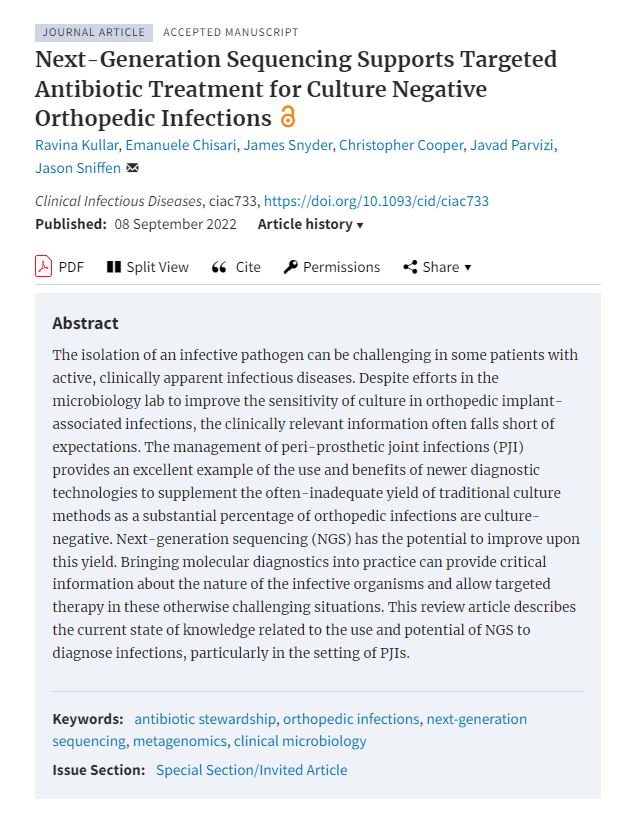
Next-Generation Sequencing Supports Targeted Antibiotic Treatment for Culture Negative Orthopedic Infections
Infectious Disease Society of America 08 September 2022
Article: Bringing molecular diagnostics into practice can provide critical information about the nature of the infective organisms and allow targeted therapy in these otherwise challenging situations. This review article describes the current state of knowledge related to the use and potential of NGS to diagnose infections, particularly in the setting of PJIs. Read Study
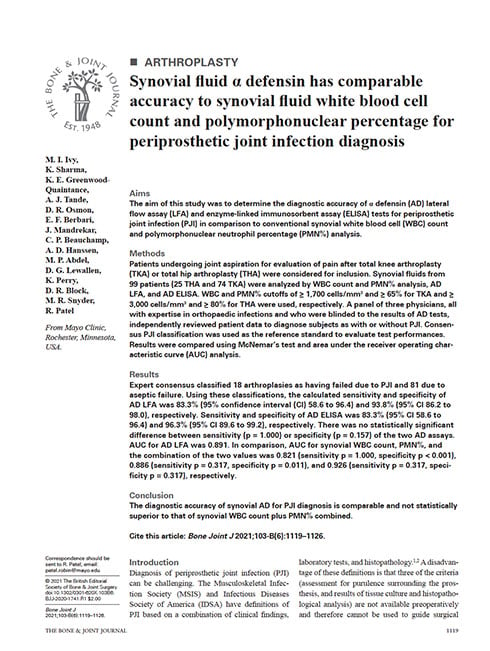
Synovial fluid α defensin has comparable accuracy to synovial fluid white blood cell count and polymorphonuclear percentage for periprosthetic joint infection diagnosis
The Bone & Joint Journal Vol. 103-B, No. 6
Article:The aim of this study was to determine the diagnostic accuracy of α defensin (AD) lateral flow assay (LFA) and enzyme-linked immunosorbent assay (ELISA) tests for periprosthetic joint infection (PJI) in comparison to conventional synovial white blood cell (WBC) count and polymorphonuclear neutrophil percentage (PMN%) analysis. Read Article
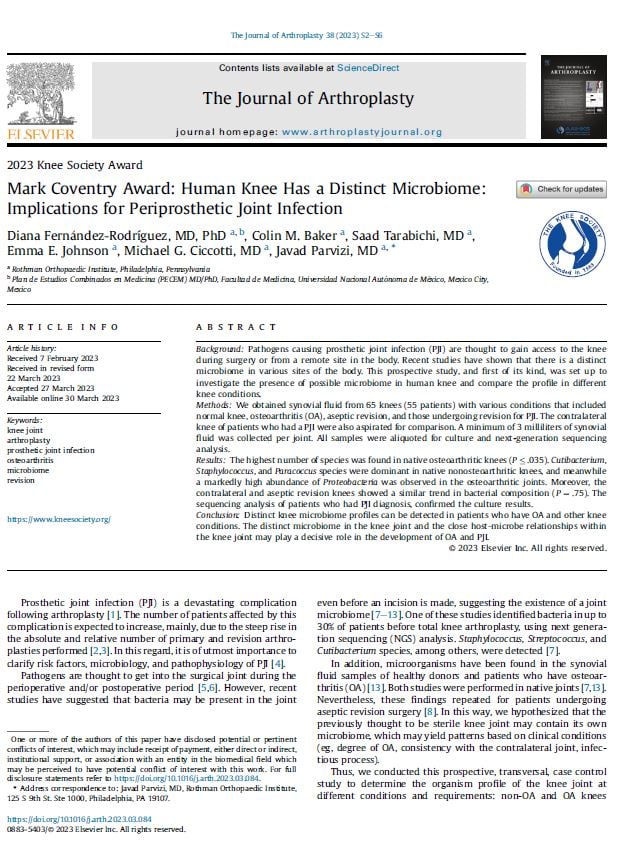
Mark Coventry Award Human Knee Has a Distinct Microbiome Implications for Periprosthetic Joint Infection
The Journal of Arthroplasty 38 (2023) S2-S6
Study: This prospective study aimed to investigate the presence of a possible microbiome in the human knee and compare the microbial profiles in different knee conditions. Synovial fluid samples were collected from 65 knees with various conditions, including normal knees, osteoarthritis, aseptic revision, and prosthetic joint infection (PJI). The results revealed that there is a distinct knee microbiome, with different microbial compositions observed in different knee conditions. These findings suggest that the knee microbiome may have an impact on the development of osteoarthritis and PJI. Read Study
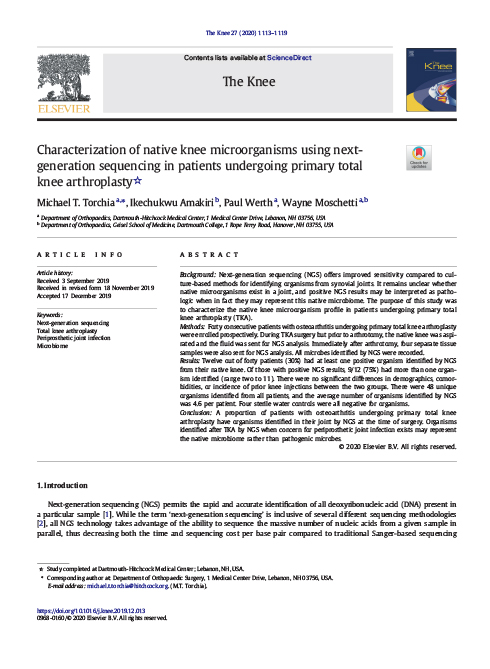
Characterization of native knee microorganisms using nextgeneration sequencing in patients undergoing primary total knee arthroplasty
Science Direct
Research Article: A proportion of patients with osteoarthritis undergoing primary total knee arthroplasty have organisms identified in their joint by NGS at the time of surgery. Organisms identified after TKA by NGS when concern for periprosthetic joint infection exists may represent the native microbiome rather than pathogenic microbes. Read Article
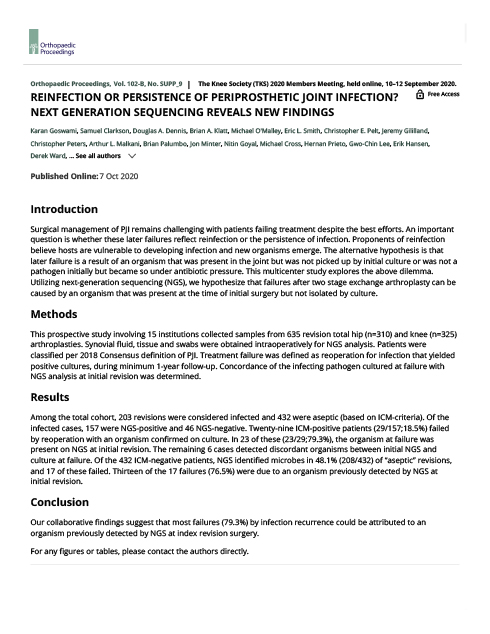
Reinfection or Persistence of Periprosthetic Join Infection? Next Generation Sequencing Reveals New Findings
Orthopaedic Proceedings
Research Article: Surgical management of PJI remains challenging with patients failing treatment despite the best efforts. An important question is whether these later failures reflect reinfection or the persistence of infection. Proponents of reinfection believe hosts are vulnerable to developing infection and new organisms emerge. Read Article
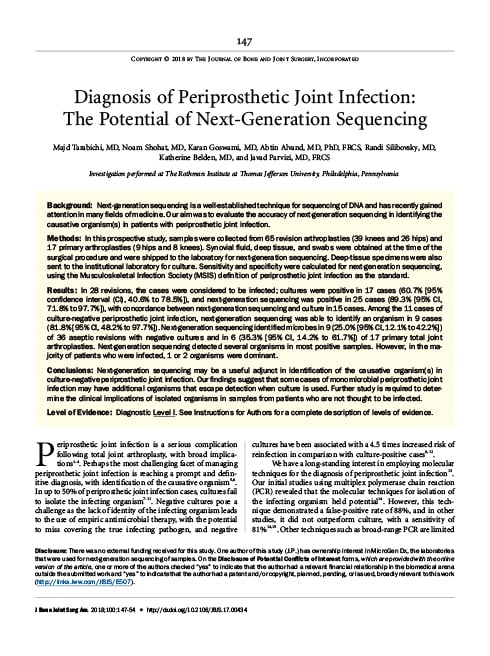
Tarabichi M, Shohat N, Goswami K, et al. Diagnosis of Periprosthetic Joint Infection: The Potential of Next-Generation Sequencing.
J Bone Joint Surg Am. 2018;100(2):147-154.
Study: A prospective study evaluated the accuracy of next-generation sequencing (NGS) in identifying synovial and deep tissue infective microbes in periprosthetic joint infection patients (65 revision arthroplasties and 17 primary arthroplasties). In infected tissues, culture identified 17 cases and NGS 25 cases. NGS identified microbes in 9 of the aseptic revisions with negative cultures and in 6 of the primary total joint arthroplasties. NGS identified additional organisms that escaped detection via culture methods. Read Study
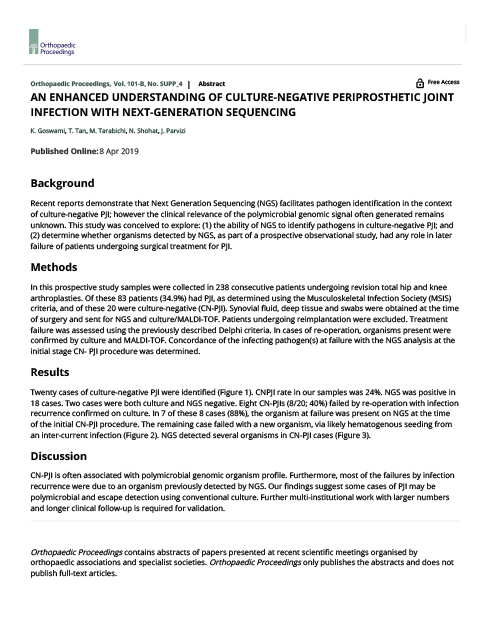
An Enhanced Understanding of Culture-Negative Periprosthetic Joint Infection With Next-Generation Sequencing
Orthopaedic Proceedings
Research Article: In this prospective study samples were collected in 238 consecutive patients undergoing revision total hip and knee arthroplasties. Of these 83 patients (34.9%) had PJI, as determined using the Musculoskeletal Infection Society (MSIS) criteria, and of these 20 were culture-negative (CN-PJI). Synovial fluid, deep tissue and swabs were obtained at the time of surgery and sent for NGS and culture/MALDI-TOF. Read Article
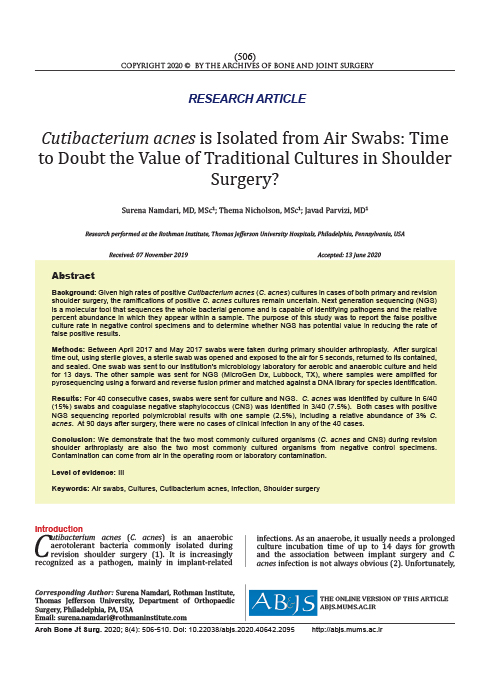
Cutibacterium acnes is isolated from Air Swabs - Time to Doubt the Value of Traditional Cultures in Shoulder Surgery?
Archives of Bone and Joint Surgery
Research Article: Given high rates of positive Cutibacterium acnes (C. acnes) cultures in cases of both primary and revision shoulder surgery, the ramifications of positive C. acnes cultures remain uncertain. Next generation sequencing (NGS) is a molecular tool that sequences the whole bacterial genome and is capable of identifying pathogens and the relative percent abundance in which they appear within a sample. Read Article
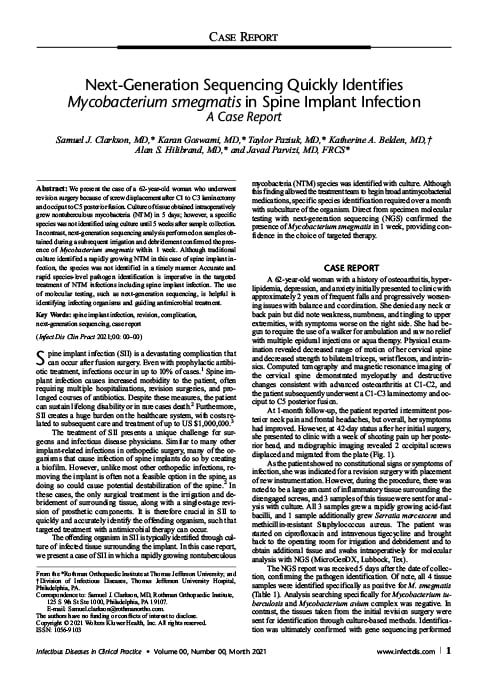
Next-Generation Sequencing Quickly Identifies Mycobacterium smegmatis in Spine Implant Infection - A Case Report
Allergy & Rhinology
Case Report: We present the case of a 62-year-old woman who underwent revision surgery because of screw displacement after C1 to C3 laminectomy and occiput to C5 posterior fusion. Culture of tissue obtained intraoperatively grew nontuberculous mycobacteria (NTM) in 5 days; however, a specific species was not identified using culture until 5 weeks after sample collection. Read Report
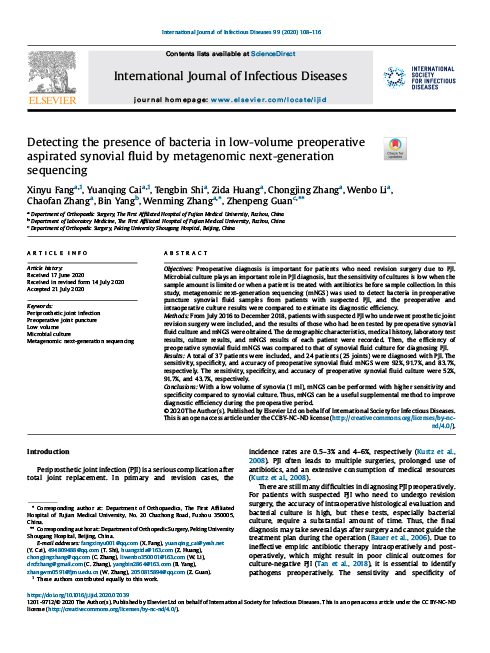
Detecting the presence of bacteria in low-volume preoperative aspirated synovial fluid by metagenomic next-generation sequencing
International journal of infectious diseases
Research Article: With a low volume of synovia (1 ml), mNGS can be performed with higher sensitivity and specificity compared to synovial culture. Thus, mNGS can be a useful supplemental method to improve diagnostic efficiency during the preoperative period. Read Article
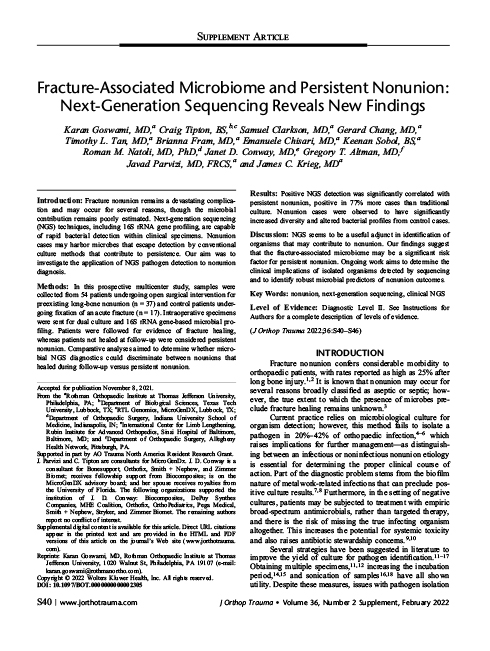
Fracture-Associated Microbiome and Persistent Nonunion - Next-Generation Sequencing Reveals New Findings
Journal of orthopaedic trauma
Research Article: Positive NGS detection was significantly correlated with persistent nonunion, positive in 77% more cases than traditional culture. Nonunion cases were observed to have significantly increased diversity and altered bacterial profiles from control cases. Read Article

Torchia MT, Austin DC, Kunkel ST, Dwyer KW, Moschetti WE. Next-Generation Sequencing vs Culture-Based Methods for Diagnosing Periprosthetic Joint Infection After Total Knee Arthroplasty: A Cost-Effectiveness Analysis.
J Arthroplasty. 2019;34(7):1333-1341.
Study: A comparison was made between culture-based techniques and next-generation sequencing (NGS) relating to cost-effectiveness in diagnosing periprosthetic joint infection (PJI) after total knee arthroplasty. NGS is more sensitive than culture-based techniques for identifying microorganisms but is less specific and more expensive. A Markov, state-transition model projecting lifetime costs and quality-adjusted life years (QALYs) was constructed to determine the cost-effectiveness from a societal perspective. The primary outcome was incremental cost-effectiveness ratio, with a willingness-to-pay threshold of $100,000/QALY. Culture was not cost-effective compared to NGS, with an incremental cost-effectiveness ratio of $422,784 per QALY. One-way sensitivity analyses found NGS to be the cost-effective choice above a pretest probability of 45.5% for PJI. The results suggest that NGS should be reserved for clinical contexts with a high pretest probability of PJI. Read Study
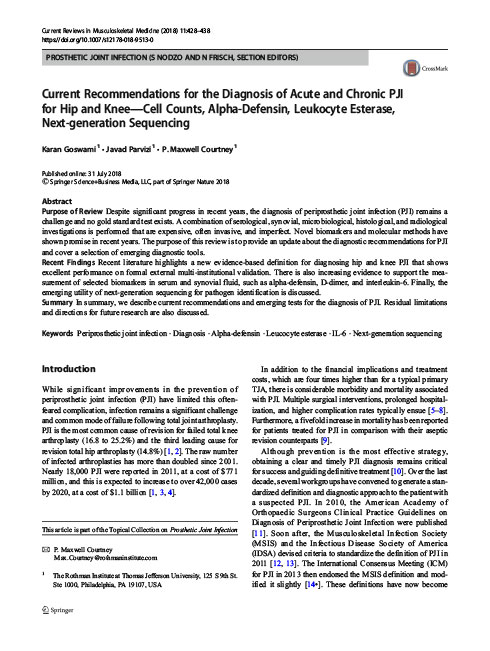
Current Recommendations for the Diagnosis of Acute and Chronic PJI for Hip and Knee—Cell Counts, Alpha-Defensin, Leukocyte Esterase, Next-generation Sequencing
Current Reviews in Musculoskeletal Medicine Vol. 11, pages428–438(2018)
Study: Despite significant progress in recent years, the diagnosis of periprosthetic joint infection (PJI) remains a challenge and no gold standard test exists. A combination of serological, synovial, microbiological, histological, and radiological investigations is performed that are expensive, often invasive, and imperfect. Novel biomarkers and molecular methods have shown promise in recent years. The purpose of this review is to provide an update about the diagnostic recommendations for PJI and cover a selection of emerging diagnostic tools Read Study
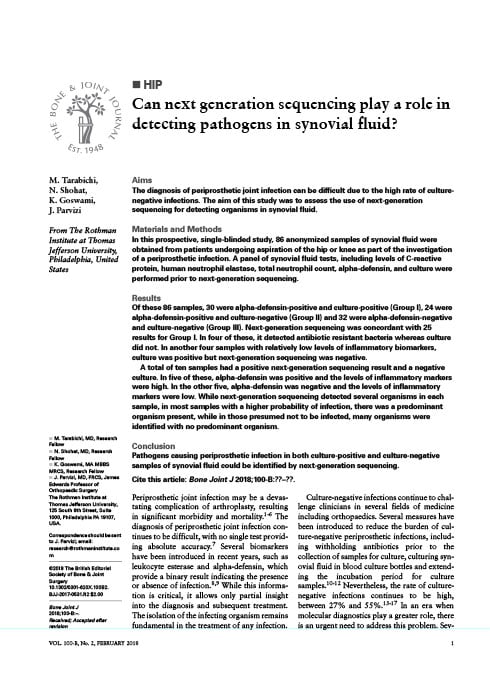
Can Next Generation Sequencing Play a Role in Detecting Pathogens in Synovial Fluid?
The Bone & Joint Journal 2018 Feb;100-B(2):127-133
Prospective Study:The diagnosis of periprosthetic joint infection can be difficult due to the high rate of culturenegative infections. The aim of this study was to assess the use of next-generation sequencing for detecting organisms in synovial fluid. In this prospective, single-blinded study, 86 anonymized samples of synovial fluid were obtained from patients undergoing aspiration of the hip or knee as part of the investigation of a periprosthetic infection. A panel of synovial fluid tests, including levels of C-reactive protein, human neutrophil elastase, total neutrophil count, alpha-defensin, and culture were performed prior to next-generation sequencing. Read Study
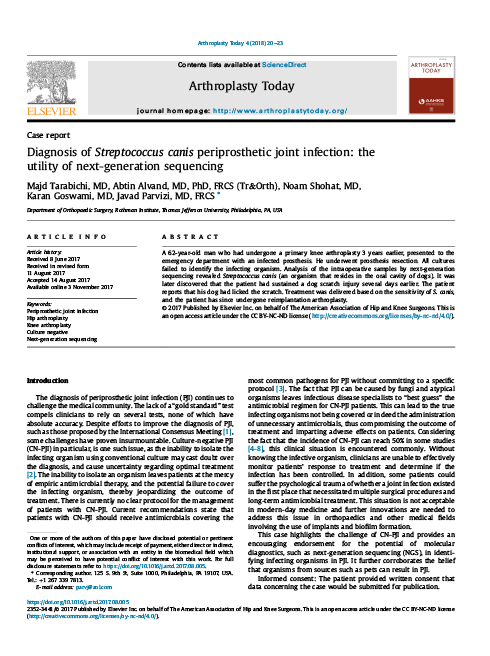
Tarabichi M, Alvand A, Shohat N, Goswami K, Parvizi J. Diagnosis of Streptococcus canis Periprosthetic Joint Infection: the Utility of Next-generation Sequencing.
Arthroplast Today. 2017;4(1):20-23.
Case Report: A 62 year old man presented with an infected prothesis from a primary knee arthroplasty three years prior. Next-generation sequencing identified the infective organism as Streptococcus canis, which cultures failed to detect. The patient was successfully treated and later underwent reimplantation arthroplasty. Read Report
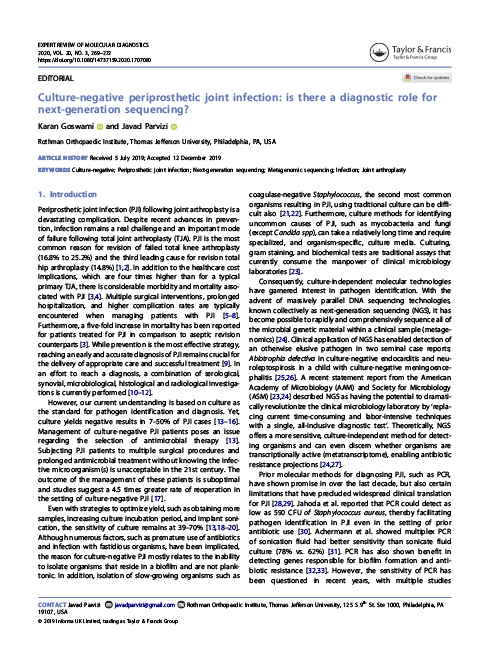
Goswami K, Parvizi J.
Culture-negative Periprosthetic Joint Infection: Is There a Diagnostic Role for Next-generation Sequencing?. 2020;20(3):269-272.
Culture-negative Periprosthetic Joint Infection: Is There a Diagnostic Role for Next-generation Sequencing?. 2020;20(3):269-272.
Expert Rev Mol Diagn. 2020;20(3):269-272.
Editorial: This review explores the utility of next-generation sequencing (NGS) in diagnosing microbial pathogens in periprosthetic joint infections (PJI). Theoretically, NGS does not suffer from the limitations associated with PCR and culture methods. NGS offers advantages such as processing speed and accuracy, among others. Although several questions regarding the clinical application of NGS remain, review of the literature finds NGS recognizing a greater number of PJI-dwelling microbes and a broader base upon which to apply treatment options. Read Editorial
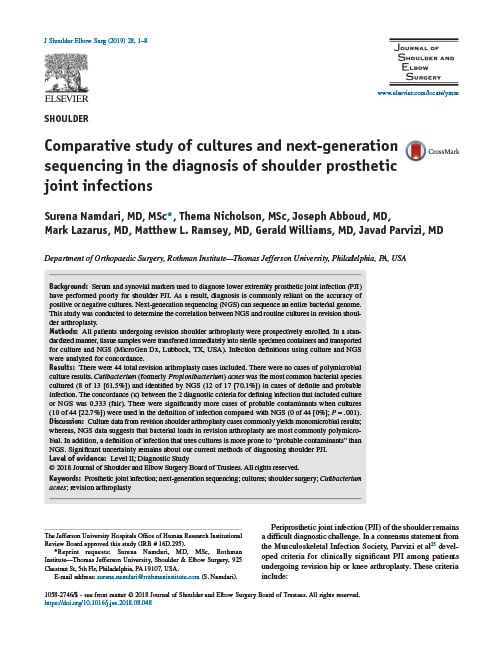
Namdari S, Nicholson T, Abboud J, et al. Comparative Study of Cultures and Next-generation Sequencing in the Diagnosis of Shoulder Prosthetic Joint Infections.
J Shoulder Elbow Surg. 2019;28(1):1-8.
Comparative Study:In a prospective study, routine cultures and next-generation sequencing (NGS) were compared in tissues taken from 44 revision shoulder arthroplasty patients. Defined infection definitions were used when analyzing culture and NGS for concordance. There were no polymicrobial culture results, whereas the NGS results suggested most the infections were polymicrobial. Read Study
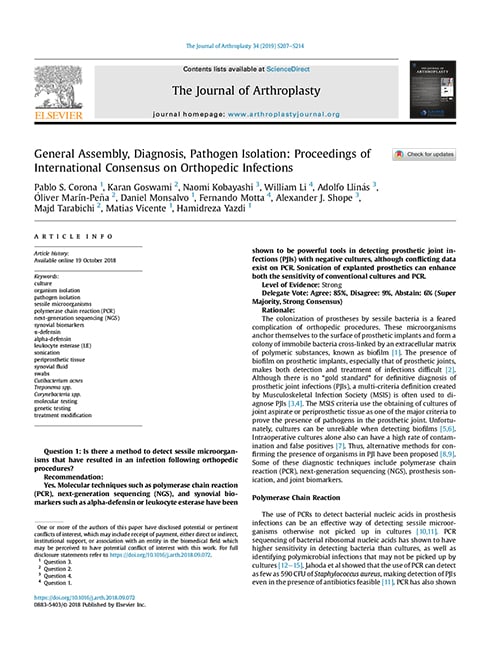
Corona PS, Goswami K, Kobayashi N, et al. General Assembly, Diagnosis, Pathogen Isolation: Proceedings of International Consensus on Orthopedic Infections.
J Arthroplasty. 2019;34(2S):S207-S214.
Summary: 85% of assembly delegates agree that molecular techniques such as next-generation sequencing (NGS) have been shown to be powerful tools in detecting prosthetic joint infections (PJIs) with negative cultures. Read Summary
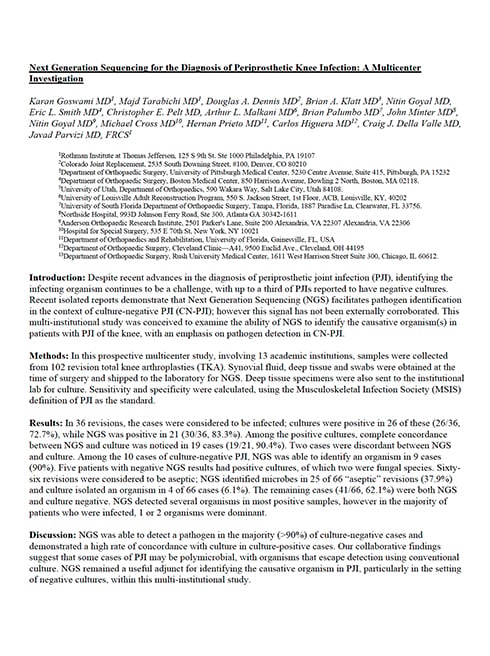
Goswami K, Tarabichi M, Shohat N, et al. Next Generation Sequencing for the Diagnosis of Periprosthetic Knee Infection: A Multicenter Investigation.
AAHKS 2018 Annual Meeting press release; Dallas, November 3, 2018.
Press Release: A multi-institutional study examined the ability of next-generation sequencing (NGS) to identify the causative organism(s) in patients with PJI of the knee. Recent reports demonstrate that NGS facilitates pathogen identification in culture-negative PJI (CN-PJI); however, this signal has not been externally corroborated. From 13 academic institutions, samples from 102 TKA revisions were examined via NGS. NGS identified microbes in 9 of 10 culture-negative patient samples and 25 of 66 “aseptic” revisions; culture identified microbes in 4 of 66 samples. NGS was able to detect a pathogen in >90% of culture-negative cases and demonstrated a high rate of concordance with culture in culture-positive cases. The collaborative findings suggest NGS is a useful adjunct for identifying the causative organism in PJI, particularly in the setting of CN-PJI. Read Press Release
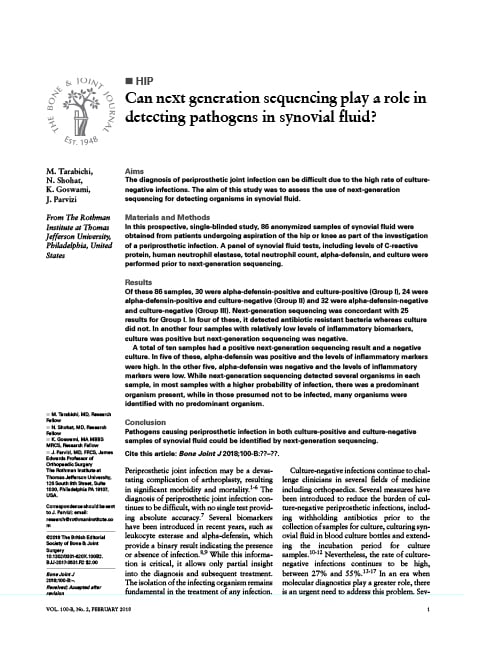
Tarabichi M, Shohat N, Goswami K, Parvizi J. Can Next Generation Sequencing Play a Role in Detecting Pathogens in Synovial Fluid?.
Bone Joint J. 2018;100-B(2):127-133.
Study: In a prospective, single-blinded study, periprosthetic joint infection was assessed in 86 synovial fluid samples from patients undergoing aspiration of the hip or knee. Next-generation sequencing (NGS) identified periprosthetic microbial pathogens in both culture-positive and culture-negative samples of synovial fluid. Unlike culture results, NGS detected antibiotic resistant pathogens in four cases; in 10 culture-negative samples, NGS identified positive results. Read Study
